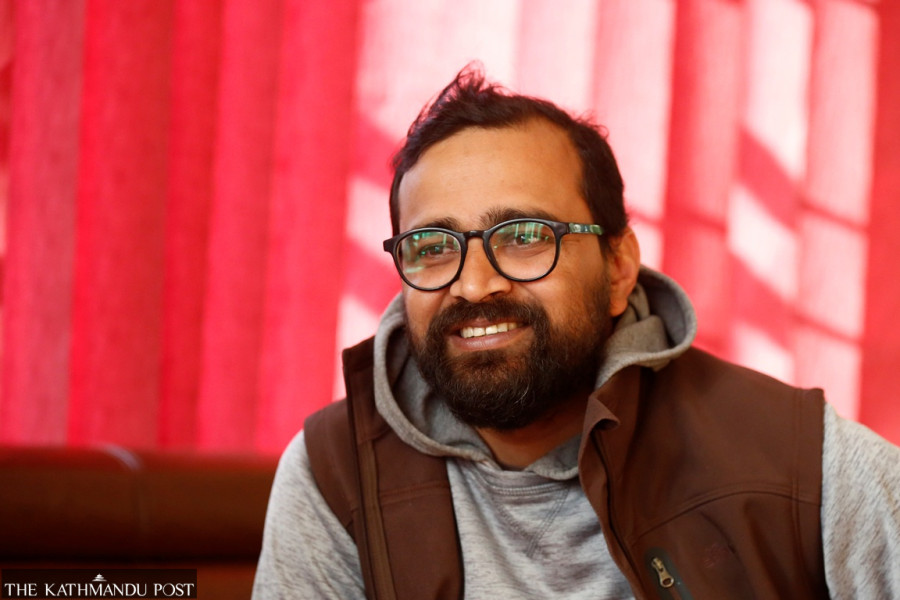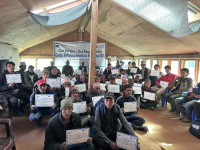Culture & Lifestyle
‘Unlike in the past, the film industry today is more open to experimenting’
Arjun Karki, popularly known as Swami, shares his years of experience working in Nepal’s film industry, how he ended up becoming an editor/colourist, and what got him involved in starting the Pame Film Festival.
Pinki Sris Rana
Born in Ramechhap, Arjun Karki has tried every single work involved in the filmmaking process only to find himself enclosed in the four walls of post-production. After completing a bachelor’s degree in computer engineering from Pokhara, Karki started pursuing a career in coding and graphic designing, but when he started cultivating an interest in filmmaking, the world around him subsequently changed.
"While working as a graphic designer, we worked a lot with pictures. Then, I started clicking pictures and editing them myself. That is when I first tried my hand at photography, and it has been irreversible since then. That is how my journey started in this industry," says Karki.
Karki, aged 40, now has worked for more than a decade in Nepal's film industry. From managing itineraries of actors and filmmakers to directing, Karki has been involved in every aspect of the filmmaking process before focusing entirely on the post-production process, which he admits is because of his love for visuals. Karki has worked as a production designer, editor, production manager, cinematographer, producer, and colourist in mainstream movies and independent films. He is also the festival director of the upcoming Pame Film Festival.
Karki sat down with the Post's Pinki Sris Rana to talk about his career, experiences in different filmmaking roles, and recent endeavours. Excerpts:
We don’t often hear stories of computer engineers changing career paths to become filmmakers. What made you make that change, and how did your parents react?
Every birthday each year, my mother would take me to a photo studio to click my pictures. My love for visuals stemmed from that point on. It took me a while to get on track with what I liked. Professionally, I was coding and working as a graphic designer, but I kept pursuing photography for my own interest. And while pursuing photography, I got interested in filmmaking. It was not until 2008 that I decided to focus on filmmaking entirely.
Unlike coding, which is a very solitary process, filmmaking involves working with many people, and I think I enjoyed that. Since the masses watch films, the public tends to take a keen interest in knowing the people involved in the film industry. If I were a software developer or even a graphic designer, a certain few would have known me, but today, I am known by many.
Talking about my parents, they did not even know that I was involved in films. They knew I had graduated with a bachelor’s degree in computer engineering and that I was working in graphic designing and such. Only when they saw my name featured in film credits did they know what I had been doing all this time. My parents never objected to my decisions, and I think that was their way of supporting their son and his dreams.
In your early days in the film industry, you worked as a director, but instead of continuing in that role, you decided to become an editor and a colourist. What made you make that transition?
Ten years ago, when I started getting involved in filmmaking, people didn’t really know the intricacies of the filmmaking process. The aspect that the majority of outsiders were familiar with was the role of a director, and that was how I also ended up as a director. But once I entered this field, I began to understand the different aspects of filmmaking. I started becoming more interested in editing and colouring, for these two roles are heavily involved in playing with the visuals and helping turn the vision of the director and cinematographer into reality.
You also received a NEFTA award for the best colourist in 2020 for the film 'Hari'. How did you feel when you received such recognition from the film fraternity?
Yes, both the cinematographer and the colourist of the film were awarded in their respective categories. The film's cinematographer had done an amazing job, and I, as a colourist, made sure that I did justice to his work in the post-production. And to have my effort recognised on a national level was a huge honour. The nominees in the best colourist category also included veteran colourists who have done amazing work over the years. Getting selected from such an experienced list did make me a bit uncomfortable.
Many say that Nepali films do not experiment much with colour and that most movies have the same glossy texture. What do you think of this?
That’s absolutely true. Even today, many directors and producers are only concerned with making their films look glossy and actors and actresses looking their best. The work I do largely depends on the work directors and producers want from me. Many still do not get what colours signify and the kind of feelings or mood they depict. But the scenario is definitely changing. ‘Hari’ was one of the films where I was given full liberty to work on, and it was recognised by the people who understood it. But things are changing for the better. Unlike in the past, the film industry today is more open to experimenting, which makes me hopeful.
You were one of the brains behind the Pame Film Festival, which debuted in 2014. How did the idea for the festival come about?
A few decades ago, when there were no local film festivals in the country, Nepali filmmakers didn’t have a platform to come together and talk about films and network with each other. But this started changing when a few film festivals started getting hosted in Kathmandu, and we were happy to be part of the festivals and meet fellow filmmakers and talk about the craft that we so love. But those festivals weren’t very inclusive, which led us to start the Pame Film Festival.
How is the Pame Film Festival any different from the other film festivals in Nepal?
Other film festivals in the country solely celebrate filmmakers, but the Pame Film Festival is designed in such a way that it involves not just filmmakers but also sound and costume designers, colourists, editors. Our goal is to make the festival serve as a platform for every artist involved in filmmaking to connect with one another.
If you look at the names of almost every film festival, you will see that they have a specific target group or issue. With the Pame Film Festival, we wanted to create a festival that is not limited by particular issues but aims to celebrate works of young independent filmmakers. We also decided to hold the festival in Pokhara because we wanted it to be the first festival not based in Kathmandu. Since Pokhara is also a renowned travel destination, we thought it would also be a fun retreat for filmmakers participating in the festival.
Basically, the Pame Film Festival is a platform for everyone involved in the filmmaking process to come together, share knowledge and ideas, talk about their works, and network.
(Pame Film Festival is being held in Pame, Pokhara from December 27 to 31.)




 15.12°C Kathmandu
15.12°C Kathmandu















